![]()
![]()
![]()
Use LEFT and RIGHT arrow keys to navigate between flashcards;
Use UP and DOWN arrow keys to flip the card;
H to show hint;
A reads text to speech;
21 Cards in this Set
- Front
- Back
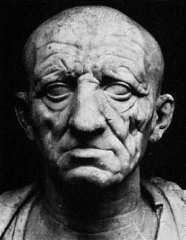
N: D: P/S: A: P: OL: M/T: F: C: DT:
|
N: Head of Roman Patrician D: 400-440 BCE P/S: The Republic A:Unknown P: Themselves, family worship OL: Rome M/T: Marble, bronze or terra cotta F: Iconic, Tribute C: Republic ideals of society DT: "Veristic" busts; real portraits of patricians or politicians; Busts displayed facial imperfections |
|
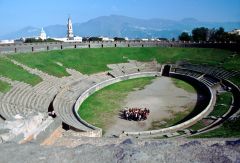
N: D: P/S: A: P: OL: F: C: DT: |
N: Pompeii Amphitheater D: 80 BCE P/S: The Republic A: Unknown P: Quinctius Valgus and Marcius Porcius OL: Pompeii M/T: Stone F: outdoor event venue C: oldest roman venue; 100 years older than colosseum; hosted sporting events/gladiators DT: oval arena; enclosed stadium; people close to the action
|
|
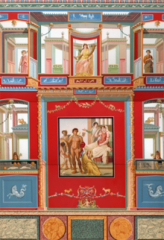
N: D: P/S: A: P: OL: M/T: F: C: DT: |
N: House of Vettii D: 80 BCE P/S: The Republic A: Unknown P: Vettis restutitus & vettis conviva OL: Pompeii M/T: stone F: luxurious lifestyle C: a famous home (domus) of antiquity; lifestyle of roman values; opportunity & immoral values DT: Well designed rich home; atrium( garden inside a home); doric columns
|
|

|
N: First style wall painting D:200- 800 BC P/S: The Republic A: unknown P: owner of the villa OL: Samnite villa, Pompeii M/T: Paint on wet plaster concrete walls F: False luxurious lifestyle C: imitation of near east style; faux painting creates appearance of wealth; vivid colors are sign of wealth DT: "masonry on incrustation style"; multi-colorful faux appearance of masonry blocks or marble slabs; faux painting makes surface of wall appear flat |
|
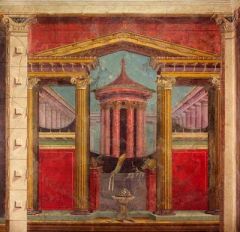
|
N: Second Style Wall Painting D: 1st century AD P/S: The Republic A: Unknown P: Owner of the villa OL: Pompeii M/T: Paint on wet plaster, concrete walls F: display social statues C: 3D appearance created; influenced of greek hellenism; illusion of perspective DT: Illusionistic or architectural style; landscape scenes of nature, greek hellenism & other villas; windows & porticos seen too |
|
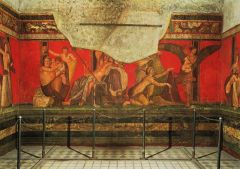
|
N: Dionysus Mystery Frieze D: 1st century BCE P/S: The Republic A: Unknown P: owner of the villa OL: villa of mysteries, Pompeii M/T: (buon) fresco F: dining room, narrate initiation into the cult C: illusion of perspective; female marrying into cult of Dionysus DT: progression of a female ceremony; greek mythology w/ dionysus |
|
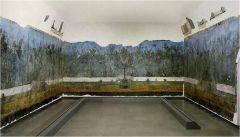
|
N: Gardenscape D: 20-30 BCE P/S: The Empire A: unknown P: empress Livia, wife of Octavian Augustus OL: villa of livia, Primaporto M/T: buon fresco F: create nature in a windowless room C: illusion of perspective; a 'picture window mural'; creates depth DT: illusionistic 3D; detailed garden of bushes, trees, flowers, and birds |
|
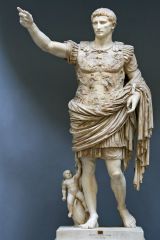
|
N: Augustus of Primaporta D: 20 CE P/S: The Empire A: unknown P: Livia OL: Villa of Livia, Primaporta M/T: Marble F: iconic tribute, narrates history C: idealistic depiction; greek hellenist influence; doryphoros by polykelitos DT: 1st Empire of Rome; Militaristic icon art; breastplate bah relief; drapery was symbol of war |
|
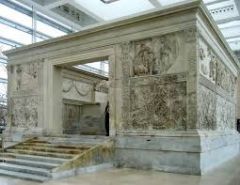
|
N: Ara Pacis D: 9 BC P/S: The Empire A: Unknown P: Augustus OL: Rome M/T: Marble F: iconic tribute C: religious and vivil narration of augustus and roman mythology DT: marble altar in tribute of augustus; relief sculpted bi level register surrounding the altar |
|
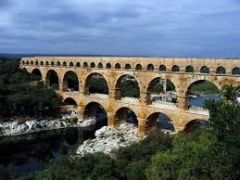
|
N: Pont-Du-Gard D: 16 BCE P/S: Imperial P: Augustan OL: France M/T: limestone blocks, very little mortar F: bridge and transport water C: Augustan Project; Engineering genius-gravity DT:3 tiered Aqueduct/bridge; 1st tier-bridge; 2nd tier decorative; 3rd tier aqueduct |
|
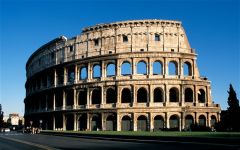
|
N: The Colosseum D: 80 AD P/S: Imperial A: unknown P: emperor vespasian OL: Rome M/T: stone blocks and mortar F: Entertainment Area DT: elliptical amphitheater; hypogeum- underground rooms/ tunnels; wooden/graval flour; seating 50,000 & 80,000; had 80 entrances/ exits |
|
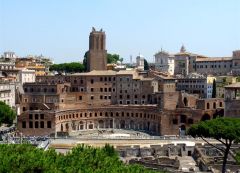
|
N: Market of Trajan D: 100 AD OL: Rome P: Unknown A: Unknown C: It was a market for trading goods DT: A market
|
|
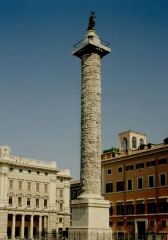
|
N: Column of Trajan D: 113 AD P/S: Imperial A: Apollodorus of Damascus P: Trajan OL: Rome M/T: Marble C: narrative of trapans victory over the Dacians; star of war, it's preparations, order from trajan, and battle w/ the Dacians DT: Free standing column; 22 layers of a spiraling narrative frieze; Bas relief; 185 step spiral staircase inside shaft
|
|
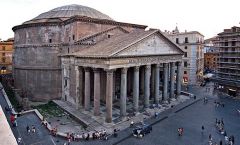
|
N: Pantheon D: 118-125 AD P/S: Imperial A: Unknown P: Hadrian OL: Rome M/T: Marble and concrete C: use of space to shape architecture; unreinforced cement dome DT: circular temple; portico of corinthian columns w/ pediment; Rotunda
|
|

|
N: Portrait bust of a Flavian women D: 90 AD P/S: Imperial A: unknown P: unknown C: hair style was a priority of Roman society; hair was flamboyant; simple/natural style mean lower social class; social status determine style of hair; F: iconic, social status symbol DT: bust of a noble woman; idealized face; hair style of many ringlets & bun in the back |
|
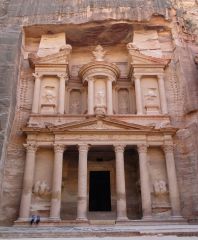
|
N: El Khazneh D: 1st century AD A: unknown P: unknown C: translation means the treasury but it is a mausolemn(tomb); influence of greece/roman in this arabic land cause it belonged to roman empire; F: tomb DT: sculpted into a cliff; greek/roman facade; corinthian columns and small pediment |
|

|
N: Equestrain statue of marcus aurelius D: 175 AD, P/S: imperial A: unknown OL: Rome C: hand gesture is godlike, like augusts, he was a studious leader; DT: victorious emperor on his horse; disproportionate- body larger than the horse; face is idealistic Me: depicts victory but could mean he is binging peace to the empire. He was last emperor bringing peace to the empire. |
|
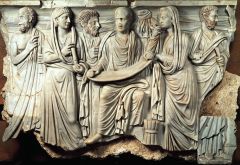
|
N: Sarcophagus of a Philosopher D: 2nd century P: unknown A: unknown M/T: bah relief C: the philosophers thoughts DT: implication of 6 philosophers really close to each other to represent how they dispute with each others ideas
|
|
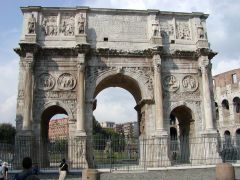
|
N: Arch of Constantine D: 312 & 315 CE P/S: Severan Dynasty OL: Rome, Italy P: Constantine A: The builders C: most of the design was taken from other sculptural decorations; F: represenths the victory of constantine DT: triple arch passage ways; liberator urbis ; |
|
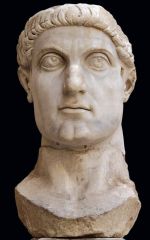
|
N: Portrait of Constantine D: 315-330 CE OL: Basilica nova, rome, italy P: constantine M/T: Marble C: this was partially destroyed after Constantine's victory over Maximus DT: a sculpted figure of constantine head. Body-less, but it is said he held the orb of world power. |
|
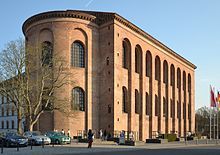
|
N:Aula Palatina D: 310 AD OL: Germany M/T: Stone P: Constantine F: palace complex C: it had wall heating systems called hypocaust DT: a building for constantine |

